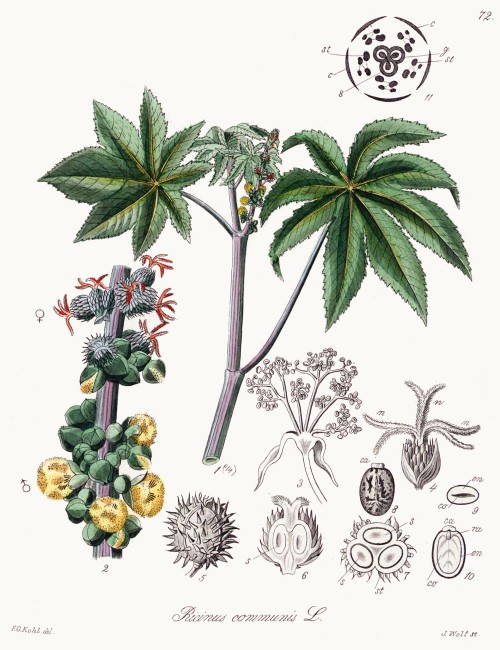Ricinus communis L. - Euphorbiaceae - castor, castor bean, castor oil plant, palma christi, Rizinus, Wunderbaum
Annual to perennial monoecious shrub, native to East and Northeast Africa and the Middle East; often single-stemmed, whole plant often reddish or purplish; leaves palmately 7-11-lobed, peltate, serrate; flowers in panicles, small; male flowers yellowish-green, stamens creamy; female flowers with red stigmas; fruit a 3-seeded spiny or smooth capsule; seeds 7-12mm, grayish, silvery, or beige with darker markings. http://www.efloras.org/florataxon.aspx?flora_id=2&taxon_id=200012604
„The oil that is stored in the endosperm of castor beans is meant to provide the embryo with energy during its germination. However, at least 6,000 years ago in ancient Egypt, humans had already discovered the usefulness of castor seed oil and took Ricinus communis into cultivation. Since these ancient times until the present day, ‘castor oil’ is used as a lubricating laxative to relief constipation. Taken in moderation, castor oil does just that but an overdose will inflict explosive diarrhoea. Accompanied by painful cramps, the latter can last for hours, causing unpredictable involuntary bowel movements of considerable magnitude even during sleep.“ http://www.kew.org/discover/blogs/ants-constipation-murder-and-seeds-ricinus-communis
The seed oil (used as laxative) is extracted by cold pressing to avoid the highly toxic lectin ricin from dissolving in the oil. Ingestion of only two seeds may be fatal… „Ricinoleic acid, which is formed from triglycerides under the influence of lipase in the small intestine, enhances the formation of prostaglandin E2, endogenous NO and the release of serotonine and histamine. These properties reduce the net resorption of fluids and electrolytes, and stimulate peristalsis.“
[Medicinal Plants of the World. Ben-Erik Van Wyk and Michael Wink, Pretoria 2004, 274]
„Castor oil, also known as Oleum Palmae Christi, is obtained from the seeds of Ricinus communis and has been used therapeutically for centuries, being first described in the Ebers papyrus of ancient Egypt more than 3,500 y ago. Castor oil is a triglyceride characterized by a high content of the hydroxylated unsaturated fatty acid ricinoleic acid [(9Z,12R)-12-hydroxyoctadec-9-enoic acid]. After oral ingestion of castor oil, ricinoleic acid is released by lipases in the intestinal lumen, and considerable amounts of ricinoleic acid are absorbed in the intestine. The released ricinoleic acid induces a strong laxative effect. There is also a well-documented labor-inducing effect of castor oil in pregnant females at term; however, use of this drug for labor induction is not recommended because of unwanted effects, such as nausea.
… the EP3 prostanoid receptor is specifically activated by ricinoleic acid and… mediates the pharmacological effects of castor oil. In mice lacking EP3 receptors, the laxative effect and the uterus contraction induced via ricinoleic acid are absent…
In contrast to oleic acid, ricinoleic acid was able to displace 3H-PGE2 from EP3 receptors expressed in CHO cells with an IC50 of 500 nM… ricinoleic acid-induced laxative effects are not a result of formation of prostanoids but are the result of a direct activation of EP3 receptors by ricinoleic acid. “
[Castor oil induces laxation and uterus contraction via ricinoleic acid activating prostaglandin EP3 receptors., Tunaru, S., Althoff, T.F., Nüsing, R.M., Diener, M., Offermanns, S., Proceedings of the National Academy of Sciences, 109(23), 2012, 9179-9184] http://www.pnas.org/content/109/23/9179.full

Kohl,F.G., Die officinellen Pflanzen der Pharmacopoea Germanica, t.72 (1891-1895)
http://plantgenera.org/species.php?id_species=882833
